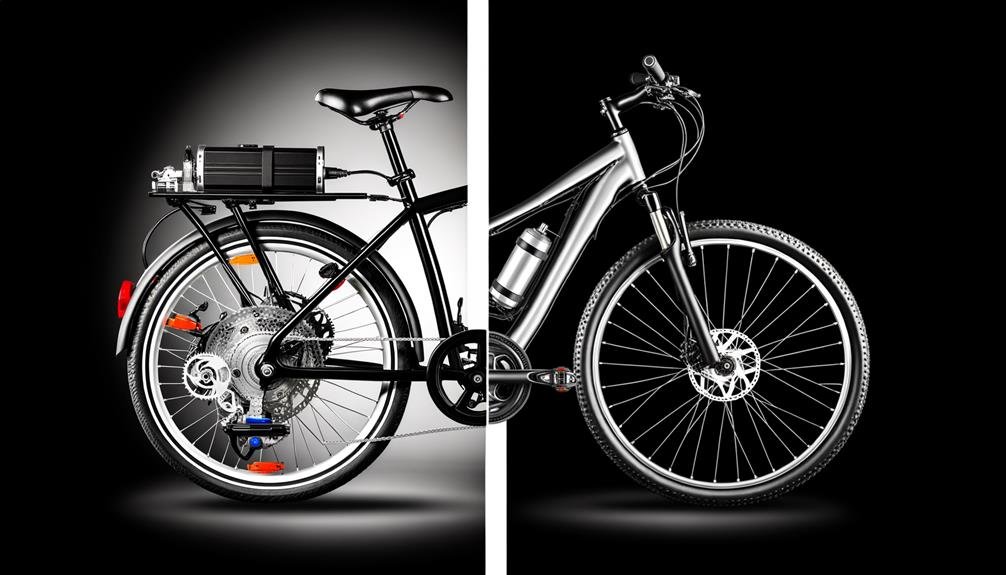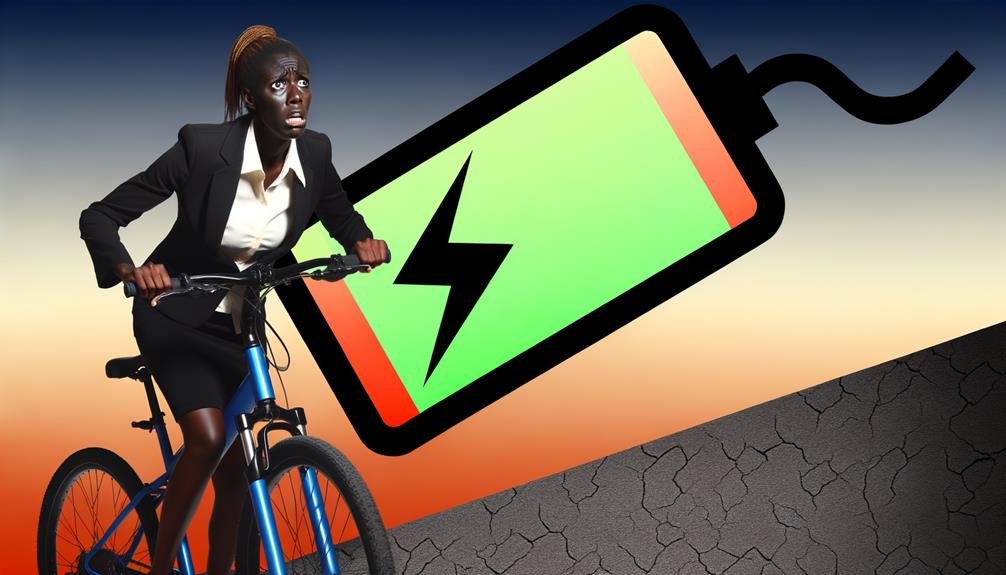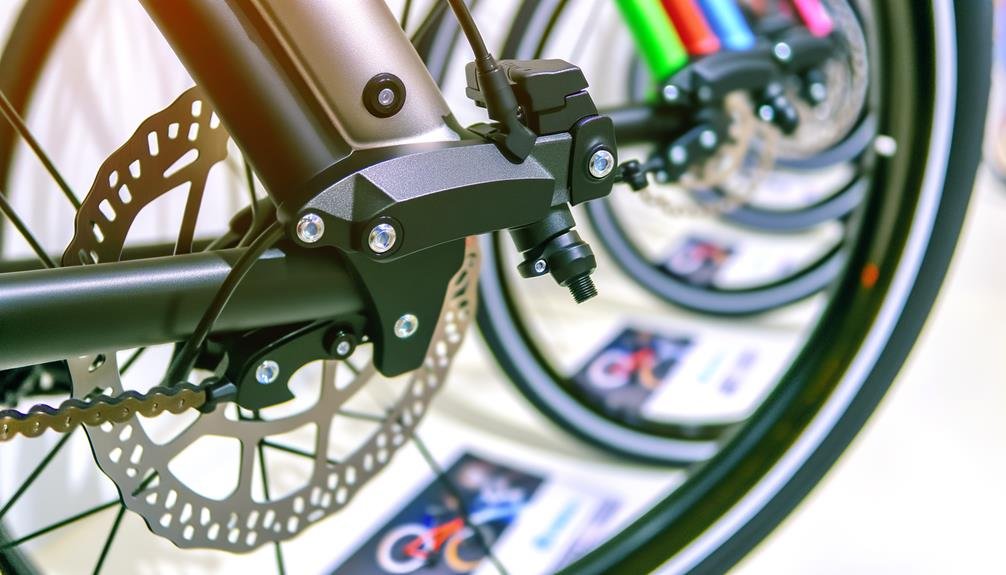Charles Miller is a veteran bike enthusiast with over 12 years of experience dealing with bikes as a mechanic. Despite immense love and expertise for...
The versatility of an electric bike, commonly known as an e-bike, is often a focal point of discussion among cycling enthusiasts and environmentalists alike.
One question that often arises is whether you can use an e-bike manually, in the absence of electrical assistance. This question opens up an intriguing discourse on the flexibility, mechanics, and adaptability of e-bikes.
Understanding the ability to switch between power-assisted and manual pedaling modes may reshape perceptions about the practicality of e-bikes and extend the conversation into the realm of their potential impact on physical fitness and environmental sustainability.
- Key Takeaways
- Understanding Electric Bikes
- Manual Versus Electric Operation
- The Mechanics of E-Bikes
- Pedaling an E-Bike Without Power
- Impact of Battery Removal
- E-Bike's Motor: A Game Changer
- Multiple Pedaling Modes
- Advantages of Manual E-Bike Usage
- The Versatility of Electric Bikes
- Is Manual E-Bike Operation Recommended?
- Frequently Asked Questions
- Conclusion
Key Takeaways
- Electric bikes have both manual and electric modes, offering unique advantages and considerations.
- Manual mode allows for exercise, traditional pedaling satisfaction, and serves as a backup plan in case of battery failure.
- Pedaling an e-bike manually conserves battery power but might not match the efficiency of a normal bike due to the heavier weight.
- The decision to use an e-bike manually depends on personal preference, physical ability, and the nature of the journey.
Understanding Electric Bikes

Delving into the realm of electric bikes, it is essential to note that these innovative machines, equipped with electric motors, batteries, cadence sensors, and efficient braking systems, offer a unique blend of convenience, flexibility, and exertion. This enables riders to either utilize the motor for a seamless ride or turn it off for a more physically demanding experience.
Understanding electric bikes involves recognizing their dual functionality. E-bikes can be ridden manually without the motor. However, the added weight from the battery and motor makes this a more challenging form of exercise, offering both exertion and leisurely rides for different cyclists.
Moreover, it is possible to use an e-bike manually, even without its battery. Certain features, such as pedal assist and motor, won't function, thus requiring more physical effort and serving as a practical backup plan if the battery runs out mid-ride.
The decision to use an electric bike manually ultimately depends on personal preference, with factors such as flexibility, speed, ease of pedaling, and weight being significant considerations. Therefore, can you use an electric bike manually? Absolutely. But having a fully charged battery is vital for switching back to electric mode, allowing for a unique blend of manual and electric cycling.
Manual Versus Electric Operation
The operation of electric bikes encompasses both manual and electric modes. Each mode offers unique advantages and considerations. Understanding the mechanics behind these modes is integral to fully utilizing the bike and optimizing the rider's experience.
From evaluating the pros and cons of manual mode, to learning how to seamlessly shift between modes, we will explore the complexities and conveniences inherent in these dual-function machines.
Understanding Electric Bike Mechanics
In comprehending the peculiarities of electric bike mechanics, it is crucial to note that these machines strike a remarkable balance between manual and electric operation, employing components such as electric motors, batteries, cadence sensors, and efficient braking systems. Electric bikes offer an amalgamation of traditional cycling and modern electric propulsion, allowing users to either pedal manually or use the motor for assistance. Understanding electric bike mechanics provides insights into their versatile nature.
| Electric Bike Components | Function | Manual/Electric |
|---|---|---|
| Electric Motor | Provides propulsion, reducing the need for pedaling | Electric |
| Battery | Powers the electric motor and other electrical components | Electric |
| Cadence Sensors | Detects pedaling speed and effort, controlling motor assistance | Both |
| Braking System | Ensures safe and efficient stops, often recharging the battery | Both |
This table offers a snapshot of the blend of manual and electric elements in an e-bike's operation.
Manual Mode: Pros and Cons
Undeniably, the decision to utilize an electric bike's manual mode hinges on several factors, including the rider's fitness level, the bike's weight, personal preference, and the flexibility of switching between modes during a journey.
When one chooses to use an electric bike manually, the pros and cons must be carefully considered. Manual mode offers the benefit of exercise and the satisfaction of traditional pedaling, without the motor. However, e-bikes are heavier, making manual operation more demanding.
Yet, the ability to switch between modes during a ride offers unmatched flexibility, catering to different riding preferences and situations. This flexibility is particularly beneficial for e-bike rentals, where varied user needs must be accommodated.
Shifting Between Modes Seamlessly
Having considered the pros and cons of manual operation, let's now explore the seamless shifting between modes that electric bikes offer, a feature that allows riders to tailor their cycling experience between manual and electric operation as per their needs and circumstances.
When you use an E-bike, you have the option to switch between multiple power modes. The first mode is the off-mode for manual pedaling. This allows riders to experience the traditional feel of cycling, using their own power to propel the bike forward.
The second mode is the low-level electric assistance for longer rides. In this mode, the motor provides a gentle boost to the rider's pedaling efforts, making it easier to cover longer distances without getting too tired.
The third mode is the high-level electric assistance for uphill battles. When faced with steep inclines or challenging terrains, riders can switch to this mode to receive maximum assistance from the motor, helping them conquer tough uphill sections with ease.
This flexibility empowers riders to ride an electric bike manually when they desire a workout, and use the motor for an effortless ride when tired. Shifting between modes seamlessly is thus an essential feature of E-bikes, providing the best of both worlds.
The Mechanics of E-Bikes
The complex mechanics of e-bikes, including elements such as electric motors, batteries, cadence sensors, and efficient braking systems, fundamentally distinguish them from traditional bicycles with their lightweight frames, regular brakes, and gear controls. These mechanics allow the e-bike to offer flexibility, speed, and ease of pedaling, albeit with a heavier frame.
One key aspect of the mechanics of e-bikes is the ability to switch between manual and electric modes. This feature allows the rider to use an electric bike manually, albeit with the added weight of the motor and battery.
To further understand the differences, the table below compares key components of both types of bikes:
| E-Bike | Traditional Bike |
|---|---|
| Electric motors | Lightweight frames |
| Batteries | Regular brakes |
| Cadence sensors | Gear controls |
| Efficient braking systems | – |
| Heavier frame | Lighter frame |
E-bikes provide a unique blend of traditional cycling and modern technology. Regardless of the rider's preference, the mechanics of e-bikes offer both a sense of belonging to the cycling community and the thrill of embracing innovation.
Pedaling an E-Bike Without Power

Transitioning to manual operation of an e-bike, while challenging due to its greater weight, can offer riders the dual benefits of physical exercise and conservation of battery power.
The absence of electric assistance means riders will rely solely on their physical strength, rendering the pedal assist, motor, and cadence sensor non-functional.
This scenario underscores the flexibility of e-bikes, adapting to individual preferences for either an electrically-assisted ride or a traditional, manually-pedaled experience.
Manual Pedaling Efficiency
Despite their additional weight, electric bikes can be pedaled manually, offering a flexible option for those who wish to exercise or enjoy a leisurely ride without motor assistance. While the manual pedaling efficiency of an e-bike might not match that of a normal bike due to its heavier weight, it still provides an engaging experience. The inclusion of a pedal assist feature allows for a seamless transition between powered and manual modes, increasing versatility.
E-bikes are heavier, requiring additional effort when pedaling manually. They offer an option to switch between electric assistance and traditional pedaling. Personal preference dictates the use of the motor. Despite their weight, they can be manually pedaled for exercise or leisure. Rental options like Fancy Apple cater to various cycling preferences, including manual pedaling.
E-Bike Power Conservation
Harnessing the power of human effort, e-bikes offer the unique capability to be operated manually, even without the support of the built-in motor, although the additional weight of the e-bike can present a more strenuous challenge.
This aspect of e-bike power conservation allows riders to engage in a more traditional, albeit more physically demanding, cycling experience. Using an electric bike manually requires more effort, as features like pedal assist and the motor are inoperative without the battery.
However, this flexibility to switch between electric assistance and traditional pedaling is a testament to the e-bike's adaptability, catering to individual preferences and fitness levels.
Companies like Fancy Apple provide e-bike rentals for those keen to experience this balance of convenience and effort.
Impact of Battery Removal
When the battery is removed from an electric bike, it significantly alters the bike's functionality and the rider's experience in several impactful ways. The process of battery removal renders the bike a conventional manual bicycle, devoid of the electric assistance that e-bikes are typically praised for.
Here are five key implications of battery removal:
- The loss of electric assistance disables the bike's electric motor, pedal assist, and cadence sensor, leaving the rider to rely solely on manual pedaling for propulsion.
- Increased physical effort is required to maintain speed and travel distances, particularly on inclines and during longer rides.
- The bike's weight is reduced without the battery, making it easier to maneuver and transport.
- The ability to use the bike manually without the battery can serve as a backup plan in case of battery failure during a ride.
- Battery removal extends the flexibility to use the electric bike as a traditional bicycle, allowing riders to customize their riding experience to their preferences and needs.
E-Bike's Motor: A Game Changer

The transformative role of the electric motor in e-bikes cannot be overstated, as it fundamentally enhances the cycling experience by providing assisted pedaling, a feature that distinguishes these bikes from their traditional counterparts. This e-bike's motor: a game changer, offers assistance when you need it, empowering you to conquer challenging terrains and long distances with less effort.
Moreover, the flexibility of e-bikes allows you to use an electric bike manually, providing a more demanding workout due to their heavier weight. While it might seem counterintuitive, this dual functionality is appealing to many cyclists who value both convenience and fitness.
Riding an e-bike without the battery is also possible; however, keep in mind that doing so will deactivate certain features like pedal assist and the motor. This will require more physical effort, especially since e-bikes are heavier than regular bikes. However, for those who value the feeling of overcoming challenges and pushing their limits, the ability to ride an electric bike manually is an attractive feature.
Multiple Pedaling Modes
In light of their innovative design, e-bikes present the rider with multiple pedaling modes, including manual, electric, and a unique combination of both, thereby broadening the range of cycling experiences. This versatility allows for a customized riding experience that can be adjusted based on the rider's fitness level, journey, and mood.
The multiple pedaling modes on an electric bike include:
- Manual mode: This traditional biking mode requires physical effort, making it ideal for a challenging workout.
- Electric mode: In this mode, the motor takes over, providing a convenient and effortless ride.
- Pedal-assist mode: This offers a balance between manual and electric modes, providing assistance as the rider pedals.
- Throttle mode: Some e-bikes feature this mode, allowing for control over the motor without pedaling.
- Power levels: Riders can switch between off-mode, low-level, and high-level power settings, tailored to the desired level of assistance.
These options make the use of an electric bike flexible and adaptable to your needs. It is all about your choice and control, enhancing your sense of belonging in the cycling community. Explore the multiple pedaling modes and transform your cycling experience.
Advantages of Manual E-Bike Usage

Having explored the various pedaling modes available on an electric bike, we now turn our attention to the specific benefits garnered from utilizing the manual mode.
The advantages of manual e-bike usage are multifold, promising a versatile and rewarding experience.
For starters, an e-bike without electric assistance offers a remarkable opportunity for exercise and maintaining agility. The physical exertion of manual e-bike usage not only promotes cardiovascular health but also fosters a greater connection with the outdoor environment.
Moreover, the versatility it provides is unparalleled; enabling a traditional biking experience with the flexibility to switch back to electric mode when necessary.
In addition, manual usage acts as a reliable backup plan in the event the battery runs out midway through a ride, ensuring the journey can continue unimpeded. This flexibility caters to individual needs and preferences, contributing to an inclusive biking community.
Lastly, experiencing an e-bike manually provides an invaluable learning experience. It allows riders to appreciate the nuances between traditional and electric biking, fostering a deeper understanding and appreciation for the technology.
Thus, the advantages of manual e-bike usage extend beyond mere functionality, offering a comprehensive and enriching biking experience.
The Versatility of Electric Bikes
Diverse in their functionality, electric bikes offer a unique blend of traditional cycling and motorized assistance, thereby enhancing the user's riding experience. The versatility of electric bikes is underscored by their ability to function both manually and with motorized assistance. This adaptability presents a host of benefits, which are especially appreciated by those who value flexibility in their transportation options.
Consider the following aspects that highlight the versatility of electric bikes:
- They can be ridden manually even without the motor, allowing the rider to switch between electric assistance and traditional pedaling.
- Electric bikes can function without a battery, although certain features like pedal assist and the motor would be inactive.
- Despite the added weight making manual riding more challenging, some cyclists find this feature beneficial for a more strenuous exercise or leisurely rides.
- The flexibility to switch between manual and electric modes during a ride provides a more versatile and customizable riding experience.
- Using an electric bike manually can offer a more challenging workout and a convenient, eco-friendly mode of transport.
In essence, whether you choose to use an electric bike manually or with motorized assistance, the choice is yours. This flexibility is part of what makes electric bikes so appealing.
Is Manual E-Bike Operation Recommended?

The question of whether manual operation of an e-bike is recommended presents a multifaceted discussion. It requires an examination of the functional aspects of e-bikes, along with a careful evaluation of the potential risks and benefits associated with manual operation.
The functional aspects of e-bikes, such as their design and technology, play a significant role in determining whether manual operation is suitable. E-bikes are equipped with electric motors that provide assistance when pedaling. This feature allows riders to travel longer distances and tackle hills with ease. However, e-bikes also have different modes of operation, including manual mode, where the motor assistance is turned off.
When considering the risks and benefits of manual operation, it is essential to weigh the advantages of motor assistance against the potential drawbacks. Manual operation can provide a more traditional biking experience, allowing riders to rely solely on their own physical strength. This can be beneficial for those who want to improve their fitness levels or enjoy a more challenging ride. However, manual operation may also require more effort and stamina, particularly for longer rides or hilly terrains.
In addition, manual operation of an e-bike can have safety implications. E-bikes are generally heavier and faster than traditional bicycles, and manual operation may increase the risk of accidents, especially for riders who are not accustomed to handling these types of bikes. It is crucial for riders to have the necessary skills and experience to safely operate an e-bike in manual mode.
E-Bike Manual Functionality
Often, e-bike enthusiasts find themselves questioning the viability of using their electric bikes manually, considering the added weight and the absence of certain features like motor and pedal-assist when the battery is removed. However, e-bike manual functionality allows for flexibility in operation, bridging the gap between a traditional bicycle and an electric bike.
E-bikes can be ridden manually, although the added weight can pose a challenge. Features like pedal-assist are absent when the battery is removed. Personal preference plays a significant role in choosing to use an e-bike manually. A fully charged battery is vital for switching back to electric mode. Multiple power modes in e-bikes allow for a customizable experience.
In essence, manual operation of an e-bike offers the best of both worlds, blending traditional pedaling with the option for electric assistance.
Risks and Benefits
While using an electric bike manually is certainly feasible, it's essential to weigh the inherent risks and benefits before deciding if this mode of operation suits your specific cycling needs and preferences. The additional weight from the motor and battery can make manual use more challenging. However, for those seeking a rigorous workout or leisurely ride, this can be an advantage.
Riding without the battery is possible, but features like pedal assist won't function, requiring greater physical effort. The flexibility to switch between manual and electric modes can cater to varying cycling needs.
Ultimately, using an electric bike manually depends on personal preference, physical ability, and the nature of the journey.
Frequently Asked Questions
Can You Ride an Electric Bike Without Using the Motor?
Yes, electric bikes can be ridden manually without utilizing the motor. This method offers benefits such as motor maintenance, battery conservation, and added manual exertion for those seeking a more rigorous physical activity.
Can Ebikes Be Used Without Pedaling?
Yes, electric bikes can be used without pedaling. The throttle mechanism allows for battery-powered propulsion, though this will increase battery usage and potentially reduce longevity. Pedal resistance may also be higher in this mode.
Can You Use an E-Bike Like a Normal Bike?
Yes, an electric bike can function like a regular bike. Manual riding benefits include enhanced battery longevity and reduced e-bike maintenance. However, performance may differ due to the bike's weight and lack of electric assistance.
Do Ebikes Have to Be Pedal Assisted?
Electric bikes do not have to be pedal-assisted. However, using pedal assist can help manage pedal resistance, control speed efficiently, and prevent excessive battery drain, offering an optimal cycling experience.
Conclusion
In conclusion, the versatility of electric bikes extends beyond their motorized capabilities. Although the weight of the motor and battery can pose a challenge, pedaling manually remains an achievable task.
This option offers not only a backup plan in the event of battery failure but also an opportunity for physical exercise.
Thus, the potential of e-bikes includes both electric and manual operation, underscoring their role as a flexible mode of transportation.

Charles Miller is a veteran bike enthusiast with over 12 years of experience dealing with bikes as a mechanic. Despite immense love and expertise for his Tacoma, he rides his Trek Ebike more. Anytime you meet him, you’ll either hear him talking about Bikes, or writing about all things bikes and cars on this blog.
More Posts


